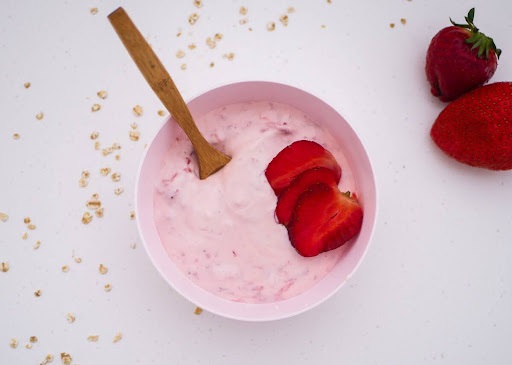
Creating your own homemade strawberry yogurt is not only rewarding but also allows you to enjoy a fresh, preservative-free treat anytime. This article will walk you through the entire process of making strawberry yogurt from scratch. The recipe is simple, requires minimal ingredients, and offers room for customization according to your taste preferences.
Introduction to Homemade Strawberry Yogurt
Homemade strawberry yogurt combines the tangy freshness of yogurt with the sweet charm of strawberries. It is a healthier alternative to store-bought versions that often contain added sugars and artificial flavors. Making yogurt at home might seem daunting, but with a few tips and straightforward steps, you can prepare it effortlessly, ensuring a delicious and nutritious result.
Ingredients Needed
To start, gather the following ingredients:
- 1 liter of whole milk
- 2 tablespoons of plain yogurt (with active cultures)
- 1 cup of fresh strawberries
- 2-3 tablespoons of honey or sugar (adjust according to your preference)
- 1 teaspoon of vanilla extract (optional)

Choosing the Right Base
The key to creamy and rich yogurt is using high-quality whole milk and active-culture yogurt as a starter. The whole milk provides a smooth, creamy texture, while the active cultures are essential for fermentation.
Preparing the Milk
- Boil the Milk: Begin by pouring the milk into a large saucepan. Heat it over medium heat until it just starts to boil. Stir occasionally to prevent the milk from sticking to the bottom of the pan.
- Cool the Milk: After the milk has reached a boiling point, remove it from heat and let it cool down to about 110°F (43°C). Use a kitchen thermometer to check the temperature.
Why Temperature Matters
The temperature of the milk is crucial for the success of your yogurt. If the milk is too hot when you add the yogurt starter, it can kill the bacteria. If it’s too cool, the bacteria won’t activate properly.
Adding the Yogurt Starter
- Prepare the Starter: In a small bowl, mix the plain yogurt with a few tablespoons of the cooled milk. Stir well until smooth.
- Combine with Milk: Add the yogurt mixture back into the pan of cooled milk. Stir thoroughly to ensure it’s well distributed.
Ensuring Even Fermentation
Mixing the starter thoroughly with the milk ensures that the bacteria are evenly distributed throughout, which is vital for even fermentation.
Incubating the Yogurt
- Cover and Wrap: Cover the pan with a lid or a clean cloth. Wrap it with a large towel to maintain the temperature and place it in a warm, draft-free area.
- Set Aside to Ferment: Allow the milk to ferment for at least 6-8 hours or overnight. The longer it ferments, the thicker and tangier the yogurt will become.
Tips for Perfect Fermentation
The fermentation environment is key. A warm kitchen or an oven with the light on provides an ideal setting. Avoid disturbing the mixture during this time to ensure successful fermentation.
Preparing the Strawberry Mixture
- Wash and Hull: Rinse the strawberries and remove the stems.
- Puree or Chop: Depending on your preference, either chop the strawberries into small pieces or puree them in a blender for a smoother texture.
- Sweeten the Berries: Mix the strawberries with honey or sugar and vanilla extract if using. Adjust the sweetness according to taste.
Combining the Flavors
- Cool the Yogurt: Once the fermentation is complete, refrigerate the yogurt until it is cold. This will also help it thicken further.
- Add Strawberries: Stir the prepared strawberry mixture into the chilled yogurt. Mix well to ensure the strawberries are evenly distributed.
Serving and Storing Homemade Strawberry Yogurt
Serve your homemade strawberry yogurt chilled. It makes a delicious breakfast option, a satisfying snack, or a dessert. Store any leftovers in an airtight container in the refrigerator. Properly stored, homemade yogurt can last for up to a week.
Enjoy Your Creation
Making your own strawberry yogurt is a fulfilling process that results in a creamy, flavorful treat that’s packed with the goodness of fresh strawberries and beneficial probiotics. Customize the flavors to suit your palate and enjoy the fresh, wholesome goodness of homemade yogurt any day!
Customization and Variation
Homemade strawberry yogurt not only tastes great but also serves as a versatile base for various flavor additions and dietary needs. Here are a few ideas to enhance and adapt your yogurt to fit your personal preferences or dietary restrictions.
Add Ins and Toppings
To enhance your yogurt experience, consider incorporating different add-ins or toppings. Here are some popular choices:
- Granola: Add crunch and fiber to your yogurt with a sprinkle of homemade or store-bought granola.
- Nuts and Seeds: Almonds, walnuts, chia seeds, or flaxseeds can provide an extra nutritional boost.
- Other Fruits: Mix in other fruits like bananas, blueberries, or mango for additional flavors and vitamins.
- Spices: A dash of cinnamon, nutmeg, or cardamom can transform the flavor profile of your yogurt.
Dairy-Free Options
For those who prefer or require a dairy-free option, you can use coconut milk, almond milk, or soy milk as alternatives to whole milk. Keep in mind that the texture and taste will vary, and you may need to use a thickener like agar-agar or gelatin to achieve the desired consistency.
Health Benefits of Homemade Yogurt
Making yogurt at home not only allows for customization but also offers various health benefits. Here are some reasons why homemade strawberry yogurt can be a healthier choice:
Probiotics and Digestive Health
Homemade yogurt is rich in probiotics, beneficial bacteria that support gut health. These cultures can help enhance digestion and boost the immune system.
Control Over Ingredients
By making your own yogurt, you control the ingredients, including the amount and type of sweetener. This is particularly beneficial for those monitoring their sugar intake or who prefer natural or less processed ingredients.
Freshness and Absence of Preservatives
Homemade yogurt does not contain the preservatives and artificial flavors often found in commercial yogurts. This means you’re enjoying a more natural product.
Making Yogurt in Different Climates
The process of making yogurt can vary depending on the climate. In cooler climates, maintaining the right temperature for fermentation can be challenging. Here are a few tips to help:
- Use an Oven: Place the yogurt container in an oven with the light on, which can provide enough warmth for fermentation.
- Use a Yogurt Maker: A yogurt maker can help maintain the optimal temperature throughout the fermentation process.
- Insulated Containers: Use containers that retain heat well, such as thermoses, to help maintain the needed temperature.
Troubleshooting Common Issues
Sometimes, homemade yogurt may not turn out as expected. Here are a few common issues and their solutions:
Yogurt is Too Runny
- Insufficient Fermentation Time: Allow more time for fermentation. Cooler temperatures may slow down the process.
- Incorrect Milk Temperature: Ensure the milk is properly cooled to the right temperature before adding the yogurt culture.
Yogurt is Too Sour
- Over Fermentation: Fermenting yogurt for too long can result in a sour taste. Reduce the fermentation time in your next batch.
Lack of Flavor
- Inadequate Flavoring: Increase the amount of strawberries, sweeteners, or add-ins to enhance the flavor.
Enjoying Your Perfect Bowl of Yogurt
Homemade strawberry yogurt is not just a treat—it’s a testament to the joys of making food from scratch. It allows you to enjoy a product that is tailored to your taste preferences and dietary needs. Whether enjoyed alone or dressed up with various toppings, each bowl of yogurt is a delightful experience in flavor and health. As you become more familiar with the process, experimenting with different fruits and flavors can make each batch a new adventure in your culinary journey.
Sustainability and Eco-Friendliness of Homemade Yogurt
One of the lesser discussed, yet highly impactful, benefits of making your own yogurt is the positive effect on the environment. Homemade yogurt substantially reduces the need for plastic packaging, a common component of store-bought yogurt. Each batch you make at home cuts down on the amount of waste generated, contributing to a healthier planet.
Reducing Carbon Footprint
By choosing to make yogurt at home, you also reduce the carbon footprint associated with transporting commercial yogurt from manufacturers to stores and finally to your home. The local sourcing of ingredients like milk and strawberries, especially if purchased from farmers’ markets or local farms, further diminishes the environmental impact.
Supporting Local Economies
When you buy ingredients from local producers, you support local farmers and small businesses, which is beneficial for your community’s economy. This support helps to maintain farming practices that are often more sustainable than those of large-scale industrial farms.
Sharing and Community Building
Homemade strawberry yogurt can also be a gateway to community building and sharing. By involving family members or friends in lunatogel the yogurt-making process, you foster a sense of community and shared purpose. This activity can be both educational and fun, especially for children, as they learn about the benefits of homemade foods.
Gifting Homemade Yogurt
Homemade yogurt also makes for a thoughtful and unique gift. Presenting a batch of your custom-made yogurt in a decorative jar can be a delightful surprise for friends, family, or neighbors. It’s a personal touch that store-bought items rarely match.
Advanced Tips for Yogurt Enthusiasts
As you get more comfortable with making basic yogurt, you might want to explore more advanced techniques and recipes. Here are a few suggestions:
Strained Yogurt (Greek Yogurt)
For those who prefer a thicker, creamier texture, straining your homemade yogurt can transform it into Greek yogurt. Simply line a sieve with cheesecloth and place it over a bowl. Pour in your yogurt and let it strain in the refrigerator for a few hours to achieve the desired thickness.

Flavored Yogurt Variations
Experiment with different flavor profiles by adding other fruit purees, extracts like almond or coconut, or even savory spices for a unique twist. Incorporating herbs like mint or basil can create refreshingly new flavors that stand out.
Using Yogurt in Recipes
Homemade yogurt isn’t just for eating on its own. It can be a versatile ingredient in baking, in sauces, marinades, or dressings, adding a touch of creaminess and tang to a variety of dishes.
Lifelong Learning and Experimentation
Making your own yogurt is more than a culinary activity; it’s a continuous journey of learning and experimentation. Each batch offers new insights and opportunities to refine your skills. Over time, you can adapt techniques and ingredients to suit changing tastes and seasonal ingredients.
Final Thoughts: A Rewarding Routine
The entire process of making homemade strawberry yogurt—from preparing ingredients to enjoying the finished product—is a rewarding experience. It empowers you to take control of what you eat and to connect with food in a more intimate and sustainable way. It encourages healthier eating habits, fosters creativity, and can even help bring people together. Whether you’re a seasoned cook or a beginner, the journey of homemade yogurt making is sure to enrich your culinary life and broaden your understanding of food.







